Categories: Featured Articles » Home automation
Number of views: 82494
Comments on the article: 9
What to do if the motion sensor does not work
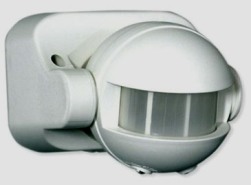 Qualified electricians have such a rule - not to consider themselves smarter than others in their profession. It means: rechecking someone’s work after commissioning some device and seeing a mismatch in the circuit, you should not immediately conclude that a gross mistake has been made here.
Qualified electricians have such a rule - not to consider themselves smarter than others in their profession. It means: rechecking someone’s work after commissioning some device and seeing a mismatch in the circuit, you should not immediately conclude that a gross mistake has been made here.
It is likely that you yourself did not fully understand the setup of this appliance, the tricks of its configuration and operation. Think about the question that has arisen, look at the documentation on it again, analyze the settings, the effect on other devices. In extreme cases, consult with colleagues.
It is likely that this is not a mistake of the previous specialist, but your ignorance of the features of this circuit and the adjustments made to its algorithm by other electricians.
This rule often helps to get rid of unpleasant situations and makes you improve your knowledge yourself. It is fully suitable for the case when you have installed a motion sensor to control your lighting, assembled a circuit to connect it, but he doesn’t work or performs some kind of “miracles”.
Do not rush to conclude that the motion sensor is broken and needs to be changed. Analyze your actions. It is possible that the reason for the malfunctioning of the lighting lies not in the sensor itself, but in its location, settings, and connection diagram.
Please note that with a working motion sensor, lighting can:
1. do not turn on;
2. Do not go out;
3. turn on completely unexpectedly.
There are simply no other variations, but if you know them, then indicate in the comments. Let's start with them in order.
With a working motion sensor, the light does not light up
To analyze this reason, we consider the usual motion sensor connection diagram, but, for simplicity, without the protective zero supplied by the PE conductor.

On it, the motion sensors are marked with numbers 1 and 2 of the terminal, the phases coming from the network and zero, and the outgoing phase wire to the lamp (terminal 3). It is conventionally shown that inside the motion sensor, its own logic circuit is connected, which controls the position of the output contact supplying voltage to terminal 3.
The corresponding phase and zero wires are connected to the terminals of the luminaire 4 and 5 from the sensor terminals 2 and 3, through which voltage is supplied to the contacts of the lamp 6 and 7 itself.
Now, we will successively consider the reasons that can affect the lack of light with a working sensor. I would like to remind you that all work under voltage should be performed by electricians with at least the 3rd group of electrical safety. After all, all that remains to be done just falls under this rule requirement because you will need to have access to contacts on which the network potential will be present.
Check for power on the sensor and lamp
To reduce the risk of electric shock, it is recommended to turn off the power supply circuit breaker and, when the voltage is removed from the circuit, provide temporary access to the connection points of the wires on the lamp and motion sensor. Then they must be mechanically locked to prevent accidental closure and then apply voltage.
Usually, electricians get by with a screwdriver-indicator and look for the presence of phase on terminal 1. If it is not there, then everything becomes clear and you need to look for the reason.
However, this is an incomplete check. After all, you still need to find out whether the potential of zero comes to the sensor. The case of its disappearance is shown in the photographs of an old electrical panel that has been in operation for about 40 years.
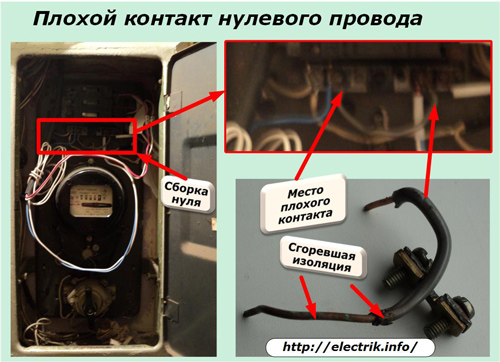
The assembly point of the neutral wires is highlighted in red. An old jumper with burnt insulation is shown from below to the right, and the place where it stood is above.The wire was inserted into a dirty terminal with construction debris and not pinched. As a result, a thick layer of soot formed. The circuit worked until the contact disappeared under load due to high heating and oxidation.
Another reason for the disappearance of the zero potential may be the deformation and subsequent breakdown of the aluminum core. Unfortunately, electricians do not always handle such fragile wires carefully.
To check immediately the presence of phase and zero potentials on the motion sensor, you need to use a voltmeter and attach its probes to terminals 1 and 2.

If an acceptable level is shown on the scale of the device, then everything is fine. Otherwise, you need to look for the cause of the lack of voltage.
The integrity of the zero wires can be called up by measuring the resistance of the sections of the circuit when the voltage is removed from the power circuit.
The correctness of the motion sensor can also be checked with a voltmeter. To do this, the probes must be connected to terminals 2 and 3. With the internal contact closed, the voltmeter will show the mains voltage.
If the probes are connected to points 4 and 5, then we determine the integrity of the circuit at the input of the lamp, and at the terminals 6 and 7 the potential difference supplied to the lamp base will be shown.
Even if there is voltage at this point, the lamp may not work due to burnout of the filament in the lamp. It will need to be replaced with a working one.
To facilitate checking the integrity of the bulb in the lamp, a switch can be installed in parallel with the output contact of the device.
Checking motion sensor settings
On the front side of the device are the setting controls:
1. SENS - level of sensitivity to the perception of infrared radiation (may not be available on simplified models);
2. TIME - period of time for the closure of the output contact of the sensor from the moment of occurrence of movement in the zone of its sensitivity;
3. LUX - restriction of switching on the device according to the level of natural illumination of the zone controlled by the motion sensor.
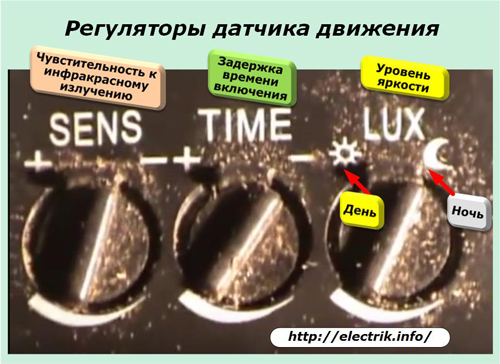
They are designed to differentially account for specific operating conditions of the device in different operating conditions. Manufacturers produce sensors that can work in a wide range of situations, but the consumer must set the position of the regulators as he needs.
If this is not done, then the sensor will not work correctly. For example, the position of the LUX lever can be selected to trigger the sensor from the light level of a dark night to a bright sunny day.
With high brightness of natural light, the LUX control is first set to the minimum position or closer to the average value of the scale. In dark places, the set point is set at the maximum value.
In the same way, set the SENS control. Its incorrectly selected infrared sensitivity setting may inhibit the operation of the entire device.
In other words, the motion sensor may simply not close its contact because the conditions set for it by the user do not allow it to be done, and changing the level of brightness or sensitivity adjustment even by a small amount can correct the situation.
Motion Sensor Location
The detection zone of moving objects is limited by the performance of the device. Outside of their range, no movement will be recorded.

When choosing a motion sensor model at the time of purchase, you must consider:
-
angles of horizontal and vertical viewing;
-
range of action.
During installation, the device must be positioned at a certain height and focused so that these parameters are optimally suited to the terrain. The coverage area has certain boundaries.
With a working motion sensor, the light does not go out
The cause of prolonged burning of the lamp may be constant movement of people or animals in the controlled space of the sensor.After all, when the moment comes for turning it off, the next movement of a person will launch an electronic circuit into work.
It’s also necessary check time delay period TIME It is possible that it has a very large value and does not allow to open the output contact that controls the lamp. The response time delay should be slightly reduced.
If LUX threshold level is too high regulator, then the blackout will also be blocked. It is necessary to lower the value of its setting.
And another reason for not turning off the light by the sensor is related to the peculiarities of its electronic circuitry, which is quite rare. When he is energized for a long time, then its contact may not be disconnected due to the occurrence of residual loads. This can be corrected by briefly turning off the power from the device and then turning it on again after 10 seconds.
Arbitrary inclusion of light
The electronic circuit of the motion sensor is designed to work in normal conditions. If you break them, then failures can occur.
For instance, irradiation of the sensor with high-frequency radio signals capable of disrupting the operation of his electronics. Therefore, it is impossible to place the device in the coverage area of the radio transmitters.
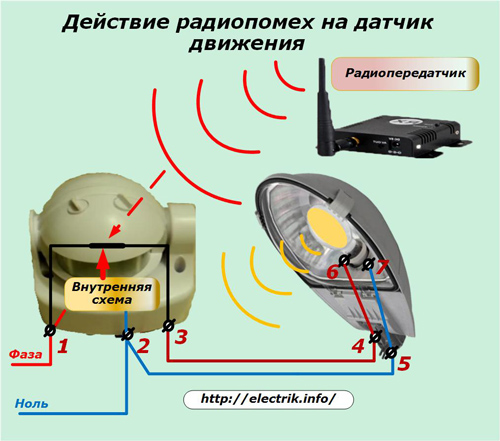
In the same way, the sensor can respond to strong electromagnetic fieldsthat are transmitted from adjacent starters, contactors, welding machines and other electromagnetic devices.
If you cannot get rid of them, then you can partially correct the situation:
1. shielding the housing from all sides (can be wrapped with foil) with mandatory grounding;
2. by coarsening the sensitivity setting with the SENS control.
Poor contact in the connecting wires It can also create electromagnetic interference in the network, cause false switching on of light.
Violation of the temperature regime of the sensor electronic circuitcaused by the operation of heaters, adjacent incandescent lamps, direct exposure to the rays of the sun leads to an accidental turn on of the lamp. Therefore, it is necessary to create obstacles and barriers in the way of the movement of thermal rays, not to allow them to influence the operation of sensitive electronics.
The reason for unexpected triggers may be movement of any objects in the working area of the devicefor example, branches of a nearby tree that sway under the influence of gusts of wind.
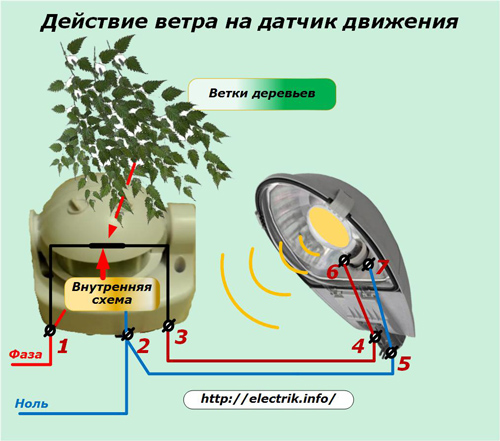
If in this zone periodically passing cars or animals, then they can also cause incomprehensible responses.
Even precipitation in the form of rain, hail and snow, and warm air emissions from fans or simply open windows can arbitrarily turn on the lamp.
Most of these reasons can be eliminated by limiting the coverage area of the controlled territory and by creating barriers to adverse factors.
To avoid all these errors, care must be taken for each place: corridor, entrance, entrance to the house, select a specific model of the device and a certain type of lamp for it.
Thus, it must be imagined that the motion sensor has a complex structure based on an electronic circuit that adapts to specific operating conditions. If you do not follow them, then even a fully functional device will not work the way we want, but will perform the algorithm of actions that is embedded in it by automation.
See also at bgv.electricianexp.com
:
